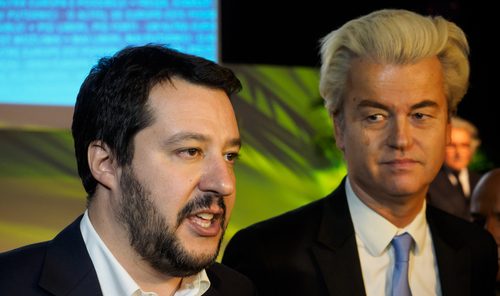Geert Wilders’ PVV comes first in Dutch elections for the first time
In the recent general election in the Netherlands, the far-right Party for Freedom (Partij voor de Vrijheid, PVV), led by Geert Wilders, won as many as 37 of the 150 seats in the lower house of parliament, with 25 per cent of the vote, more than double its 11 per cent in the 2021 election. The PVV has about half of the 76 seats needed for a majority. The victory comes after Prime Minister Mark Rutte, who has led the “frugal” country for 13 years, surprised everyone by announcing his intention to resign and retire from politics. In second place is the Green-Labour alliance, consisting of the Labour Party (PvdA ) and the Green Left (GL), led by former European climate commissioner Timmermans. Rutte’s People’s Party for Freedom and Democracy (VVD) came in third with 11 per cent, halving its vote share compared to the previous election. The PVV’s emergence as the most popular party in the Netherlands is historic and marks a shift away from only established or mainstream parties coming in first.
Historic victory, but government formation uncertain
Wilders, who was born in Venlo in 1963 and is known for his strong anti-Islamist and anti-immigration positions, declared that the PVV could no longer be ignored after its excellent election performance. While it is not a foregone conclusion that Wilders will be able to garner enough support to form a coalition capable of governing the Netherlands, it is also unclear whether the other Dutch parties will be able to keep the PVV out, as they have done in previous elections when the far-right party came in second or third. If Wilders fails to form a coalition, other parties may attempt the feat of forming a coalition together, but the possibility of a left-wing alliance seems remote, at least for the time being, as a government with such fragile support would have serious difficulties in getting its hands on the complex dossiers gripping the Netherlands, such as those related to immigration, housing or the cost of living.
On the centre-right, there is little chance of support for a Wilders-led government, at least for the time being. In particular, while Dilan Yeşilgöz-Zegerius, secretary of the VVD has dryly stated that he will not be part of a government under a man he considers divisive. Pieter Omtzigt, leader of the New Social Contract (Nieuw Sociaal Contract, NSC) party, has made coalition talks with Wilders conditional on him revising the most extreme parts of his party’s manifesto. Having ruled out the possibility of working with Wilders during the election campaign because of his extremism, particularly his Islamophobic vehemence, Omtzigt seemed far more cautious about a possible executive with Wilders on election night.
Radical right and far right: the new political mainstream
Beyond the important electoral victories of the far right, such as those of Geert Wilders in the Netherlands or Javier Milei in Argentina, to mention only the most recent ones, there is another political fact that deserves careful consideration: the increasing convergence between mainstream and radical (right-wing) politics. Milei defines himself as an anarcho-capitalist economist who draws on the most radical laissez-faire theories of the early 1900s. A libertarian radicalism that has led him over time to advocate, among other things, the buying and selling of organs and the creation of an adoption market, as well as the liberalisation of arms sales and the destruction of the central bank. Although the newly elected Argentine president refuses to align himself ideologically with the extreme right, he has chosen as his deputy Victoria Villaruel, a lawyer known for defending many of the military men convicted of crimes committed during the dictatorship,. Milei also adhered to the Madrid Charter, a document promoted by the Spanish far-right party Vox, which aims to curb the spread of communism in the Ibero-American region. There is some consensus among scholars that while the term “radical right” usually refers to populist parties with strong illiberal traits alongside nativist and authoritarian features, the term “extreme right” refers to political actors that are anti-democratic and violent. In this sense, the umbrella term “far-right” is used those to capture phenomena related to political actors whose boundaries are increasingly blurred.
In this regard, Wilders and Milei can be seen as political actors who have been shaping the political landscape for some time: electoral victories or good performances in the polls by the far right have been alternating with less good performances for decades. The electoral gains of the parties of the far right and the radical populist right are no longer a “novelty.” What is new, if anything, is the successful convergence of what we might call “mainstream politics” and “far-right politics,” that is, traditionally moderate and institutional politics with radical and extreme politics. In this sense, the term far-right, which in itself subsumes the radical and illiberal elements of the populist right with the violent and anti-democratic features of the extreme right, is now used to describe political parties and experiences that are not only widely “tolerated” by our liberal democracies, but central to them.
On the supposed “antibodies” of liberal democracies against extremism
It is a good rule to distinguish between public narratives and politics. But, it is also necessary to recognise that “institutional” politics and the “shouted” politics of rallies and slogans in the public spaces, whether physical or digital, are increasingly linked. Certain discourses have become de facto hegemonic, representing the new normal. The process of “overlapping” between once distant political subjects has allowed ideological elements of right-wing extremism, from conspiracy theories to white supremacy and nativism, to penetrate and be fully integrated, into mainstream politics and its discourses. Just think of the large family of conservative parties, which, with few exceptions, now seems to have been completely absorbed, internationally, by its populist radical right-wing populist counterpart.
It is not enough to focus political analysis on the electoral performance of the far right, as is often done. Instead, it is essential to add the awareness that, beyond the more or less positive results at the ballot box, the political fact is the transformation of a political system from within. In this respect, liberal democracies have recently often been referred to as forms of government with adequate “antibodies” to deal with possible democratic backsliding or regression.
The normalisation of the far-right and right-wing extremism
In a recent article co-authored with Federica Fazio and Christian Kaunert, entitled “The Transnationalization of the Far Right and Terrorism Across the Atlantic”, we underscore the growing influence of far-right ideologies in both Europe and North America, and the increasing willingness of far-right parties to cooperate with each other and find a common ground on key issues. In particular, the case of Donald Trump’s former chief strategist Steve Bannon illustrates how the European far-right is consolidating around shared concerns to emerge as a transnational force. In particular, Bannon promoted The Movement, a Brussels-based foundation that advocates for European right-wing populists, while also engaging with polling analysis and political campaigning. The initial aim was to broaden the foundation’s scope to transcend the traditional left-right divide, emphasising globalism and European bureaucracy as common enemies. So far, however, the practical results have been relatively modest, with recent divisions emerging among far-right parties. Notably, the French political scientist Jean-Yves Camus argued last year that Europe is currently home to at least two competing factions of the radical right: the “French-Italian” one, led by Marine Le Pen and Matteo Salvini, with Georgia Meloni as its centre, and the “Hungarian-Polish” one of Orbán’s Fidesz and Kaczynski’s PiS. At the same time, there is a resurgence of right-wing extremist groups, with far-right political violence accounting for the majority of recent terrorist incidents. These incidents reveal cross-national, even cross-continental narratives and links between far-right groups and parties.
In the aforementioned article, we also analysed how the European far-right greatly has been instrumental in fuelling negative sentiments towards migrants, unleashing a sense of ontological insecurity and fuelling the “us” vs. “them” dichotomy, using the tactics of the Hungarian government and explained why Italy risks becoming a laboratory for what could happen in other liberal democracies.
The infiltration of fundamental far-right ideological elements into mainstream politics, to the point where they are seen as somewhat “normal,” is a significant risk. This shift encompasses extreme positions ranging from nativism to white supremacy, and from conspiracy theories to anti-Semitism and Islamophobia. There is a worrying possibility that an event in the coming years could provide fertile ground for an outbreak of violence fuelled by right-wing extremist groups. In Italy, a notable incident occurred on October 9, 2021, when participants of the No Green Pass demonstration, along with members of the neo-fascist Forza Nuova party, attacked the CGIL union headquarters in Rome. This act of violence was in response to the decree-law passed by the Draghi government, which made the use of the EU digital Covid-19 certificate compulsory for access to workplaces. Similarly, recent extreme-right driven riots in Dublin followed a disturbing incident in which three children and a school care assistant were stabbed outside a primary school. These events highlight the potential for violent outbursts fuelled by right-wing extremist sentiment.
To return to the antibody metaphor, it is worth asking whether today’s liberal democracies are capable of recognising the increasingly normalised features of right-wing extremism as pathogenic and foreign bodies.
Note: This article reflects the views of the author and not the position of the DPIR or the University of Oxford.







